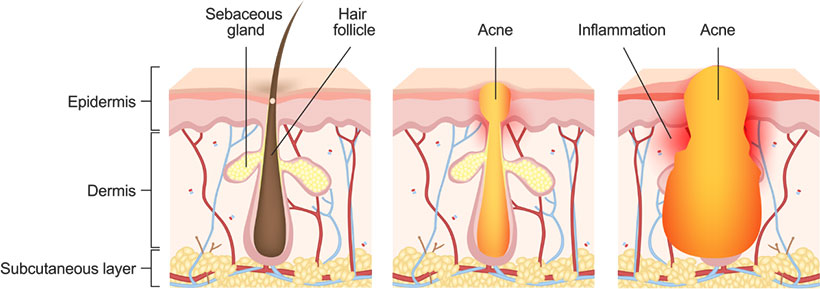Acne
Acne occurs when a hair follicle and its associated oil (sebaceous) gland become blocked and inflamed. This creates an ideal environment for bacteria—particularly Cutibacterium acnes (formerly Propionibacterium acnes)—to multiply, leading to further irritation, redness, tenderness, and swelling.
Acne affects approximately 85% of Australians at some point in their lives, most commonly from the mid-teens to mid-twenties. However, the severity and duration of acne can vary widely. For some, it presents as a few occasional breakouts, while others may experience more persistent and severe symptoms requiring professional treatment.
While acne often begins in early adolescence, it may worsen during the late teenage years. In many cases, it improves by the early 20s—but not always. It’s increasingly common for adults in their late 20s, 30s, or even older to experience acne in various forms, known as adult or persistent acne.

Types and Characteristics
Acne can present in many forms and is typically graded based on severity:
- Mild: Open and closed comedones (blackheads and whiteheads)
- Moderate: Papules and pustules
- Severe: Nodules and cysts, often deep and painful
A common aftermath of acne is post-inflammatory hyperpigmentation (PIH)—those lingering dark marks on the skin after a breakout. In more severe or unmanaged cases, hypertrophic or keloid scarring may also occur.
Equally important are the psychological impacts: acne can affect self-esteem, confidence, and contribute to anxiety and social withdrawal, especially in adolescents and young adults.
Debunking Common Acne Myths
There’s no shortage of acne “advice” floating around online and on social media—much of it misleading or outright wrong. Let’s clear a few things up:
💧 “Drink more water”
Hydration is great for overall health, but excessive water intake won’t clear your skin. Acne is not caused by dehydration.
🧽 “Exfoliate more”
If you’re dealing with active acne, your skin barrier is already compromised. Over-exfoliating, especially with scrubs, can worsen inflammation. While some gentle chemical exfoliants (like salicylic acid) may be helpful, they should be used carefully and with professional advice.
🥗 “Cut out all bad food”
There is some evidence linking high glycemic index foods and certain dairy products to acne. However, diet alone is not usually the cause. You don’t need to give up every indulgence—just be mindful of what might be contributing to flare-ups.
☀️ “Get a tan”
While sun exposure may temporarily dry out pimples, it damages your skin and increases the risk of pigmentation, scarring, and skin cancer. Some therapeutic light treatments (e.g., red and blue LED) can help—but these are very different from UV exposure.
Treatment Options & How We Can Help
Acne may eventually clear on its own, but it’s not recommended to simply “wait it out.” Without early and proper treatment, there’s a greater risk of scarring, pigmentation issues, and the psychological burden that can come with persistent breakouts.
Working with a professional can help you:
- Identify the type and cause of your acne
- Implement a structured treatment plan tailored to your skin
- Minimise long-term skin damage and improve overall skin health
- Boost your confidence and reduce the emotional toll of acne
Treatment Options May Include:
- Topical treatments (e.g., retinoids, benzoyl peroxide, salicylic acid)
- Oral medications (e.g., antibiotics, hormonal therapies)
- Clinical treatments (e.g., LED therapy, chemical peels, laser treatments)
- Lifestyle and skincare adjustments
Acne is a chronic condition, often lasting several years. Even when treatment works initially, symptoms may return if treatment is stopped too soon. Consistency is key—results often take time, and even slow progress is a step forward.
Final Word
There is no magical “quick fix.” Be wary of bold marketing claims and trendy fads promising overnight results. They often do more harm than good—and waste time and money that could be better spent on effective, science-backed treatment.
Prevention is better than cure. The sooner you seek help, the better the long-term outcome—for your skin and your confidence.